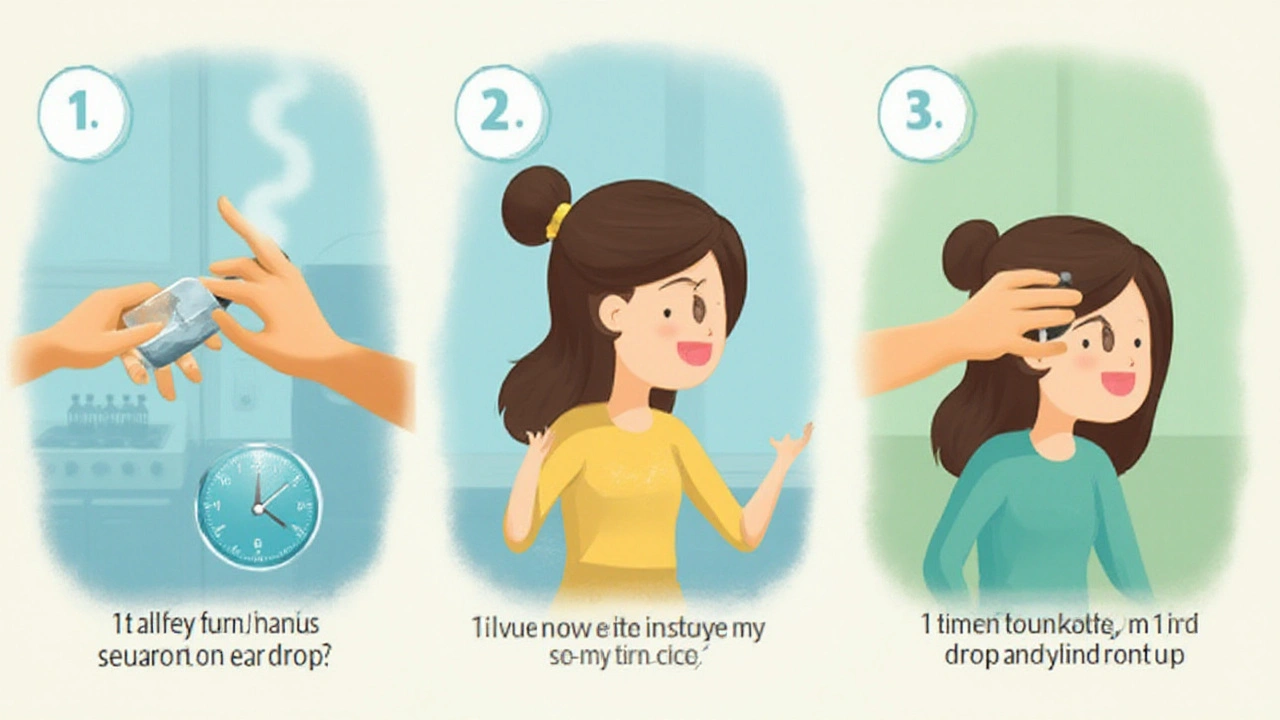Ever tried pouring medicine into your ear and ended up more frustrated than fixed? Misusing ear drops for ear infections can make things worse, not better. It’s a routine that sounds simple, yet even adults get it wrong. One tiny air bubble or wrong angle, and you’re back to square one—no relief, maybe even more pain. Getting good results starts with knowing exactly what you’re doing, why each step matters, and how a few small details can transform your treatment.
Understanding Ear Canal Infections and Ear Drops
Ear canal infections—called otitis externa or “swimmer’s ear”—pop up more often than most people think. Too much moisture, scratching inside the ear, or a splash of dirty water at the pool can let bacteria or fungi sneak in. These bugs thrive in a dark, damp canal, which is exactly what you’ve got inside your ear. Around 1 in 10 people will get an outer ear infection during their life, and in warm, humid climates, rates can soar far higher.
Your best defense? Ear drops—when used right. Most ear drops prescribed for ear canal infections contain an antibiotic, a corticosteroid to bring down swelling, or both. Sometimes, for fungal infections, you’ll get special antifungal drops. Over-the-counter products, though, often just reduce discomfort and don’t kill germs. Why does this matter? Because using the wrong type or applying drops incorrectly can mean days of pain, blocked hearing, even serious complications if the infection spreads.
One key thing to know: not all ear infections are created equal. Middle ear infections (behind the eardrum) often need oral medicine, not drops. Using ear drops when you’ve got a torn eardrum is risky too—it could let medicine reach nerves or the middle ear and cause side effects. Doctors usually check the eardrum before recommending drops. As Dr. Lawrence Lustig, a well-known otolaryngologist, puts it,
"Proper diagnosis is essential. Treating the wrong type of infection can do more harm than good."
Another eye-opener: about 33% of patients misuse ear drops, either by letting the liquid stay in the outer ear or by not finishing the course, according to a 2023 clinical survey. The good news is, getting the process right isn’t complicated once you know the steps—and it can save you a ton of discomfort.
Essential Steps: How to Use Ear Drops the Right Way
First things first: always read the instructions on your bottle or box. If the label says warm the drops in your hands, don’t skip that part. Room-temperature drops feel way more comfortable and don’t trigger that weird spinning sensation (dizzy spells happen when cold liquid hits your ear canal). Here’s a no-nonsense way to do it right:
- Wash your hands—before you touch the bottle or your ear.
- Lie on your side or tilt your head so the affected ear faces up.
- If your drops are cloudy, shake them gently as per instructions.
- Pull the outer ear up and back (for adults) or down and back (for kids under 12). This straightens the ear canal, making it easier for medicine to reach deep inside.
- Hold the dropper just above the canal. Don’t shove it in. Squeeze in the precise number of drops your doc advised.
- Stay in that position for at least two to five minutes. Yep, it sounds long, but it helps the drops coat the infected area instead of leaking out.
- Gently press on the small flap in front of your ear canal (the tragus) to help move the drops deeper.
- Wipe away extra fluid but skip cotton swabs—they push bacteria in or injure your skin.
- Repeat if your doctor told you to treat both ears.
- Wash your hands again and clean the dropper tip with a tissue if needed.
This approach keeps germs from spreading, avoids complications, and lets the active medicine do its thing. Never share your bottle, and toss out drops past their expiry date—even if there’s some left.
Still not sure you’re hitting the mark? Don’t be shy about asking your pharmacist for a live demo. Pharmacists do this daily. They’ve seen every mistake, so they have tricks, like how tilting your head just a touch further slows down the drip, which means less waste and better coverage.

Common Mistakes and How to Dodge Them
Plenty of people mess up with ear drops, and the same mistakes pop up again and again. The top goof: firing the dropper straight down the middle of the canal. This often means medicine coats only the opening, not the problem area deeper inside. Others shoot too much at once or use scalding-hot, cold, or even contaminated drops (don’t even ask what happens with old eye drops as stand-ins—it’s not good news).
Using cotton swabs with drops is an all-time bad idea. Swabs scrape the sensitive lining and send bacteria further, upping the infection risk. According to the Mayo Clinic, "cotton swabs should never enter the ear canal—leave cleaning to the outer ear only." Just because you can’t see wax doesn’t mean there’s space to go poking around.
Another mistake: quitting drops as soon as pain eases. That’s like running half a marathon and calling yourself done—the bugs aren’t all gone. Finish the full course even if your ear feels fine by day three. Skipping doses gives remaining germs a second wind and increases the risk that your infection returns, possibly meaner than before.
Forgetting to dry the ear after swimming or showering, especially during treatment, is another common trap. Use a soft towel or a blow dryer set to cool and low, held at arm’s length. Moisture feeds infections, so keeping things dry between doses is a must.
When to See Your Doctor and What to Expect
If your ear hurts a lot, drains pus, or hearing drops off quickly, don’t try to self-treat for long—get a professional’s advice. Same story if fevers, jaw pain, or headaches show up. These are signals that the infection might have gone deeper or that the eardrum could be torn.
Your doctor will usually start with an otoscope exam—a quick look to check for redness, swelling, or discharge. Sometimes they’ll clean out stubborn gunk so the medicine works better. Some people, especially kids or those with ear tubes, need custom advice. Your doctor might send a sample of ear discharge to the lab if routine drops fail. Occasionally, oral antibiotics or antifungals get added to the mix.
What about hearing loss? Most people regain their full hearing after treatment, but about 5% have lingering trouble. This is usually from swelling or debris trapped behind the eardrum, rarely permanent damage. Quick, proper treatment lowers that risk to nearly zero.
Some drops interact with other drugs, like those for high blood pressure or certain skin creams. If you have allergies or chronic health issues (such as eczema, diabetes, or immune system problems), flag these for your doctor so they can tailor your plan.
| Symptom | When to Seek Medical Help |
|---|---|
| Severe pain or swelling | Immediately |
| Yellow/green discharge | Within 24 hours |
| Fever over 101°F (38.3°C) | Immediately |
| Sudden hearing loss | Immediately |
| Symptoms worsen after 2-3 days of drops | Within a day |
Always ask about side effects and exactly what to expect during recovery. If you’re nervous, bring a friend along—that extra set of ears can pick up things you miss.

FAQs and Pro Tips: Making Ear Drop Use Easier for Everyone
How do you handle a wiggly child or an older adult with shaky hands? It’s easy to get nervous about missing your target or getting medicine on the pillow instead of in the ear. Lay kids flat, offer a treat or distraction, and bring in another adult to steady them if possible. For older adults, set up a well-lit area and use a hand mirror. Mark the correct number of drops on the bottle with a piece of tape as a simple reminder.
If you have trouble lying on your side, try propping your head against a rolled towel or pillow. Using a countdown timer or your favorite song (about two minutes) helps pass the waiting time while drops settle in. Stubborn drops that won’t leave the bottle? Warm the bottle by rolling it in your palms—never microwave bottles; too risky.
Travelers should keep ear drops in their carry-on, inside a sealed bag, to avoid messes. Extreme heat or cold can ruin medicine in hours, so ask your pharmacist about storage. Toss away after finishing, especially after an infection—it can harbor germs even if it looks clear.
And here’s a tip for people prone to frequent ear canal issues: after swimming or sweating, tip your head to drain water and dry gently. Some ENT doctors approve a homemade mix (equal parts vinegar and rubbing alcohol) to keep ears dry, but ask your doctor first if you have had ear infections or eardrum damage.
Finally, always check expiration dates before squeezing a single drop, and check back with your doctor if infection recurs. Don’t reuse or share prescription meds, even among family—it’s unsafe and possibly illegal, since what's good for one infection might not work for another.
Just a little know-how—and a dash of patience— and you’ll get real relief, with your ear drops doing their job right the first time. Here’s to healthy, infection-free ears!

julie shayla
August 2, 2025 AT 12:34Oh great, because everyone knows ear drops are the new miracle cure.
Super Mom
August 9, 2025 AT 15:00Alright everyone, here’s the quick rundown: wash your hands, tilt that head, and pull the ear back like you’re trying to listen to a whisper. Warm the drops in your palms – cold stuff feels like a tiny arctic blast in your canal. After squeezing in the right number of drops, stay still for a couple of minutes so the medicine can actually coat the infection instead of sloshing out. Gently massage the tragus to help spread it, then wipe any excess without a cotton swab (they’re a no‑no). Remember to finish the full course, even if the pain eases, because unfinished treatment invites a comeback.
Jean Tredoux
August 16, 2025 AT 17:27Pharma makes it sound easy, but they hide side‑effects and push cheap bottles that aren’t sterile.
cedric Gicquiaud
August 23, 2025 AT 19:53Look, the real problem isn’t the dropper angle, it’s the misinformation spreading across forums. Everyone thinks a quick tilt works, yet the eardrum anatomy demands precise pulling of the pinna to straighten the canal. If you skip the warm‑hand step, the cold can trigger vertigo, making you think the drug failed. Also, wiping the outer ear with a cotton swab after drops is a classic move that pushes debris deeper. Follow the guide step‑by‑step and you’ll avoid the nightmare of a secondary infection.
Mason Grandusky
August 30, 2025 AT 22:19Picture this: you’re a tiny sailor navigating a stormy sea of wax and bacteria, and those ear drops are your lighthouse. By warming the bottle, you’re basically giving the lighthouse a friendly glow that guides the medicine straight to the gunk. Staying still for two minutes feels like an eternity, but it’s the difference between a quick rescue and a shipwreck. And hey, pressing the tragus isn’t just a trick – it’s the secret handshake with your inner ear that says, “Hey, let’s get this cured!”
Spencer Riner
September 7, 2025 AT 00:45The guide nails the practical steps, but it also hints at a bigger picture: ear health is often overlooked until pain forces us to act. Consistent dryness after swimming can cut down recurrence rates dramatically. Also, keeping a timer handy ensures you actually wait those crucial minutes instead of rushing back to your phone.
Joe Murrey
September 14, 2025 AT 03:11i reckon most folks just skip the warm‑hand thing ‘cause they’re in a hurry. trust me, the extra few seconds make a world of diff.
Tracy Harris
September 21, 2025 AT 05:37While the preceding comments convey enthusiasm, it is imperative to emphasize the gravitas of adhering to aseptic technique. The utilization of non‑sterile applicators constitutes a breach of protocol, potentially precipitating iatrogenic infection. Moreover, the omission of post‑administration observation undermines therapeutic efficacy. Consequently, practitioners must inculcate a disciplined regimen to safeguard patient outcomes.
Sorcha Knight
September 28, 2025 AT 08:03OMG, I tried the trick of letting the head hang off the pillow and it actually worked! 😱💪
Jackie Felipe
October 5, 2025 AT 10:29yeah thats pretty cool but dont forget to clean the bottle tip.
debashis chakravarty
October 12, 2025 AT 12:55Allow me to elucidate the myriad linguistic and procedural missteps observed in the foregoing discourse. First, the phrase \"warm the drops in your palms\" should be rendered as \"warm the drops by gently cupping them in your hands\" to convey the intended action with precision. Second, the term \"ear canal\" is a noun phrase that must be consistently capitalized when referring to the anatomical structure in a formal treatise; thus, \"Ear Canal\" is preferred. Third, the use of the conjunction \"and\" in a compound sentence necessitates a comma preceding it, yielding a serial comma for clarity: \"wash your hands, tilt your head, and pull the ear back\". Fourth, the imperative \"stay still for two minutes\" lacks an article; the correct formulation is \"stay still for a period of two minutes\". Fifth, the recommendation to \"press the tragus\" should be expanded: \"gently press the tragus to facilitate distribution of the solution\". Sixth, the admonition against cotton swabs ought to cite the authoritative source, for instance, \"The Mayo Clinic advises that cotton swabs never enter the ear canal\". Seventh, the statement \"finish the full course\" must be contextualized with the phrase \"even if symptoms abate\" to avoid ambiguity. Eighth, the sentence \"keep a timer handy\" benefits from a clarifying modifier: \"keep a digital timer or smartphone alarm handy\". Ninth, the instruction \"wipe any excess\" requires the preposition \"with a clean tissue\" for completeness. Tenth, the suggestion to \"warm the bottle\" should caution against using a microwave, as excessive heat may degrade the pharmaceutical compounds. Eleventh, the paragraph on \"dryness after swimming\" would be strengthened by referencing empirical data on recurrence rates. Twelfth, any mention of \"pharma\" must be qualified to avoid unsubstantiated insinuations; a balanced tone is essential. Thirteenth, the pronoun \"you\" should be replaced with \"the patient\" in formal medical guidance. Fourteenth, the document would benefit from a concluding sentence summarizing the protocol: \"Adherence to these steps ensures optimal therapeutic outcomes and minimizes complications\". Finally, the overall structure should employ numbered headings for each major step, enhancing navigability. By integrating these linguistic refinements, the guide will achieve both grammatical rigor and instructional clarity.
Daniel Brake
October 19, 2025 AT 12:34It’s fascinating how such a simple routine can embody a micro‑philosophy of care: respecting the body’s boundaries while gently coaxing it toward healing.